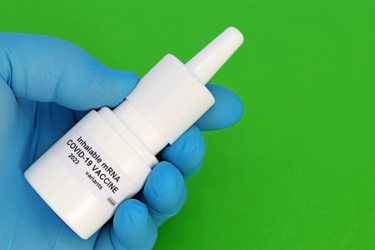A Promising Approach To Develop An Inhalable, Temperature-Stable COVID-19 Vaccine
By Apoorva Daram and Nitesh K. Kunda, St. John's University

COVID-19, caused by SARS-CoV-2, affected millions of people worldwide and was declared a global pandemic by WHO1,2, prompting research scientists across the world to prioritize vaccine development. The development of vaccines is usually a tedious process, but COVID-19 vaccines were developed at an accelerated speed to limit the spread and achieve immunity to this virus.3 Various vaccine candidates, both approved and those in clinical trials, have employed the spike protein as a potential antigen for generating an immune response against SARS-CoV-2.3,4
The Limitations Of Currently Available COVID-19 Vaccines
The coronavirus spike glycoprotein (S) attaches to the ACE2 receptor on human cells, facilitating viral entry and subsequent infection.5 A natural respiratory infection stimulates the production of mucosal (IgA) and systemic (IgG) antibodies. IgA protects the upper respiratory tract, while IgG protects the lower respiratory tract.6 Traditional vaccines, administered as an intramuscular injection, elicit a systemic (IgG) immune response that offers limited protection for the upper respiratory tract. While traditional vaccines induce moderate immune responses, they do not provide complete sterilizing immunity.
An optimal vaccine, however, should stimulate both mucosal and systemic immune responses to effectively safeguard both the lower and upper respiratory tracts.7 Current COVID-19 vaccines are either mRNA/DNA vaccines in lipid-based drug delivery systems or inactivated virus-based vaccines. The vaccines targeting the spike protein induce IgG antibodies, but they offer limited protection to the upper respiratory tract since they are administered through the parenteral route.8 To generate both IgA and IgG immune responses, research on the next-generation vaccines currently under development is exploring alternative administration routes such as intranasal or pulmonary routes.9
Currently, approved vaccines are administered parenterally and require trained medical personnel. Further, the vaccines depend on a cold chain (minus 80 to minus 20 °C) to maintain the stability and integrity of the antigen from the point of manufacture to the point of immunization, which significantly increases the cost of the vaccine. In low- and middle-income countries, lack of infrastructure such as cold chain and trained medical personnel for administering these vaccines limits eligible individuals' vaccination. These limitations present bottlenecks and restrict the ability to achieve mass vaccination or booster doses. Therefore, there is a need to develop effective and reliable vaccine formulations that are noninvasive, scalable, affordable, and stable. To address the challenges mentioned above with liquid-based vaccine formulations, alternatives that can be administered through noninvasive routes of delivery are needed10
Inhalable Dry Powder Approach Offers Promising Benefits
Inhalable dry powder vaccines that can be administered via the pulmonary route have emerged as a promising approach. This approach offers many advantages, such as facilitating self-administration, eliminating cold chain requirements, and reducing logistical challenges associated with vaccine distribution.10 And this approach will be highly beneficial in arresting the virus at its port of entry, considering that the lungs are the primary site of COVID-19 infection. Moreover, it also offers a cost-effective solution for mass vaccination efforts that can be vital for combating pandemics effectively.10
Currently, multiple candidates that can be administered intranasally or inhaled are undergoing clinical trials or being approved globally. Several pharmaceutical companies and academic research institutes in the U.S. are working on intranasal and inhaled COVID-19 vaccines. China and India already have two approved nasal vaccine candidates. Data indicates that the nasal vaccine developed by an Indian company, Bharat Biotech International Limited, generated a better immune response than an injected mRNA vaccine. Most of the vaccines under development are using animal models or in the middle of early-phase human trials. Codagenix’s CoviLiv vaccine, which can be administered intranasally, is currently in Phase 3 clinical trials and has reported positive results from its first-in-human trials.11,12
Liposomes are nanoparticulate delivery systems that can be applied to vaccine development. These systems encapsulate or adsorb antigens to make them particulate, mimicking pathogens. This further promotes capture by antigen-presenting cells such as macrophages and dendritic cells. These systems also provide sustained release at the site of administration.13 Conjugation of the spike protein onto the liposomal surface enhances their recognition by immune cells, further boosting the immune response. In addition, incorporating adjuvants within the liposomal delivery systems can further boost the immune responses.14 In the delivery of liposomes to the lung by the inhalation route, deposition into the lungs depends on particle size, density, breathing rate, airflow, respiratory volume, and health of the individual.15 To ensure effective delivery to the lungs, liposomes must be formulated into microparticles of suitable size (1 μm to 5 μm), which can be achieved through spray-drying the liposomal suspension with suitable excipients. These microparticles, typically 1 μm to 5 μm in aerodynamic diameter, reach the deep lungs and the excipients dissolve in the respiratory environment, releasing the liposomal nanoparticles for interaction with the immune cells.16 There has been ample research on spray-drying liposomes encapsulating antigens, but there is not enough data on spray-drying antigen-conjugated liposomes because of the challenges associated with the spray-drying process. Spray-drying, however, using a combination of protective excipients such as mannitol, trehalose, and leucine, among others, and optimizing the spray-drying parameters can yield stable dry powder vaccines suitable for aerosolization and pulmonary delivery.17
This innovative approach addresses significant challenges in vaccine distribution and vaccine efficacy. Leveraging already-established technologies like liposomes and spray-drying to make thermostable and inhalable vaccines offers a scalable solution to mass vaccination. Furthermore, it allows for incorporating multiple viral antigens and adapting to evolving viral strains, ensuring long-term effectiveness against COVID-19.
In conclusion, developing inhalable dry powder vaccines significantly advances COVID-19 vaccine research. By harnessing the potential of liposomal delivery systems and pulmonary administration, these vaccines offer a promising strategy to achieve widespread immunity, particularly in resource-limited settings. Moreover, their versatility and adaptability are essential for future pandemic preparedness efforts.
This article builds on a Rapid Fire talk scheduled to be presented at the May 2024 AAPS National Biotechnology Conference.
References
- Ndwandwe D, Wiysonge CS. COVID-19 vaccines. Curr Opin Immunol. 2021;71:111-116. doi:10.1016/j.coi.2021.07.003
- Kashte S, Gulbake A, El-Amin Iii SF, Gupta A. COVID-19 vaccines: rapid development, implications, challenges and future prospects. Hum Cell. 2021;34(3):711-733. doi:10.1007/s13577-021-00512-4
- on behalf of the COVID-19 Commission of Accademia Nazionale dei Lincei, Rome, Forni G, Mantovani A. COVID-19 vaccines: where we stand and challenges ahead. Cell Death Differ. 2021;28(2):626-639. doi:10.1038/s41418-020-00720-9
- Han X, Xu P, Ye Q. Analysis of COVID‐19 vaccines: Types, thoughts, and application. J Clin Lab Anal. 2021;35(9):e23937. doi:10.1002/jcla.23937
- Hussain M, Jabeen N, Raza F, et al. Structural variations in human ACE2 may influence its binding with SARS‐CoV‐2 spike protein. J Med Virol. 2020;92(9):1580-1586. doi:10.1002/jmv.25832
- Rudin A, Riise GC, Holmgren J. Antibody Responses in the Lower Respiratory Tract and Male Urogenital Tract in Humans after Nasal and Oral Vaccination with Cholera Toxin B Subunit. McGhee JR, ed. Infect Immun. 1999;67(6):2884-2890. doi:10.1128/IAI.67.6.2884-2890.1999
- Fraser R, Orta-Resendiz A, Mazein A, Dockrell DH. Upper respiratory tract mucosal immunity for SARS-CoV-2 vaccines. Trends Mol Med. 2023;29(4):255-267. doi:10.1016/j.molmed.2023.01.003
- Zieneldien T, Kim J, Cao J, Cao C. COVID-19 Vaccines: Current Conditions and Future Prospects. Biology. 2021;10(10):960. doi:10.3390/biology10100960
- Miteva D, Peshevska-Sekulovska M, Snegarova V, Batselova H, Alexandrova R, Velikova T. Mucosal COVID-19 vaccines: Risks, benefits and control of the pandemic. World J Virol. 2022;11(5):221-236. doi:10.5501/wjv.v11.i5.221
- Muttil P, Kunda NK, eds. Mucosal Delivery of Drugs and Biologics in Nanoparticles. Vol 41. Springer International Publishing; 2020. doi:10.1007/978-3-030-35910-2
- Sullivan MG. Are covid-19 nasal vaccines really coming? Published December 19, 2023. https://www.healthcentral.com/condition/coronavirus/are-covid-nasal-vaccines-on-the-way
- Bastian H. A Major First Next Generation Covid Vaccine: Could There Be More in 2024? (Update 13). Published January 11, 2024. Accessed April 9, 2024. https://absolutelymaybe.plos.org/2024/01/11/a-major-first-next-generation-covid-vaccine-could-there-be-more-in-2024-update-13/#mucosaltable
- Wang N, Chen M, Wang T. Liposomes used as a vaccine adjuvant-delivery system: From basics to clinical immunization. J Controlled Release. 2019;303:130-150. doi:10.1016/j.jconrel.2019.04.025
- Tretiakova DS, Vodovozova EL. Liposomes as Adjuvants and Vaccine Delivery Systems. Biochem Mosc Suppl Ser Membr Cell Biol. 2022;16(1):1-20. doi:10.1134/S1990747822020076
- Kunda NK, Alfagih IM, Dennison SR, et al. Bovine Serum Albumin Adsorbed PGA-co-PDL Nanocarriers for Vaccine Delivery via Dry Powder Inhalation. Pharm Res. 2015;32(4):1341-1353. doi:10.1007/s11095-014-1538-5
- Kunda NK, Alfagih IM, Miyaji EN, et al. Pulmonary dry powder vaccine of pneumococcal antigen loaded nanoparticles. Int J Pharm. 2015;495(2):903-912. doi:10.1016/j.ijpharm.2015.09.034
- Price DN, Kunda NK, Ellis R, Muttil P. Design and Optimization of a Temperature-Stable Dry Powder BCG Vaccine. Pharm Res. 2020;37(1):11. doi:10.1007/s11095-019-2739-8
About The Authors:
Apoorva Daram is a doctoral candidate in pharmaceutical sciences at St. John’s University, working in Dr. Nitesh Kunda’s lab. She has a background as a formulation research scientist in the pharmaceutical industry and holds an undergraduate degree in pharmacy from Manipal University in India and a graduate degree in pharmaceutical sciences from Campbell University in North Carolina. She has been recognized with distinction awards during her undergraduate studies and received a faculty-endowed scholarship during her graduate program.
 Nitesh Kunda, Ph.D., is an associate professor in industrial pharmacy and pharmaceutics in the Department of Pharmaceutical Sciences at St. John's University, New York. Prior to joining St. John’s, he was a post-doctoral fellow at the College of Pharmacy, University of New Mexico, Albuquerque, with a research focus in aerosol drug and vaccine delivery. His current research interests include the use of nanotechnology in developing therapeutics against infectious disease and cancer, synthesizing polymeric nanoparticles and attaching targeting moieties for site-specific delivery, amorphous solid dispersions, and drug and vaccine formulation for pulmonary delivery.
Nitesh Kunda, Ph.D., is an associate professor in industrial pharmacy and pharmaceutics in the Department of Pharmaceutical Sciences at St. John's University, New York. Prior to joining St. John’s, he was a post-doctoral fellow at the College of Pharmacy, University of New Mexico, Albuquerque, with a research focus in aerosol drug and vaccine delivery. His current research interests include the use of nanotechnology in developing therapeutics against infectious disease and cancer, synthesizing polymeric nanoparticles and attaching targeting moieties for site-specific delivery, amorphous solid dispersions, and drug and vaccine formulation for pulmonary delivery.
